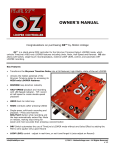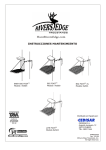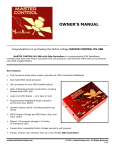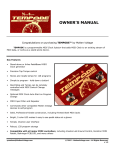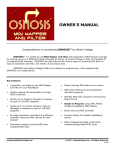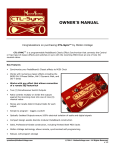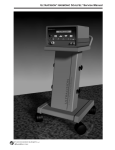Download MoltenVoltage PedalSync Datasheet
Transcript
PedalSync™ Chips MV-55 and MV-55B and Module v1.1 Key Features • Offset control allows users to offset the waveform against the incoming clock for syncopation • Real-time control of potentiometers without large waveform spikes due to extensive proprietary smoothing and interpolation algorithms • Backwards-Compatible with MIDI • Scalable - combine chips like building blocks to make elaborate designs • Efficiently Designed to ensure Low part count • Thru-Hole or SMT • Easy to create stand-alone pedals that can be used traditionally and tested in-store Tru-FootTM LFO waveform realistically emulates the sound of a foot controlling a wah-type expression pedal • Use PedalSyncTM and Tru-FootTM trademarks on your devices and in advertising Duty Cycle control allows users to skew waveforms (e.g. turn a triangle wave into a sawtooth wave) • CadSoft Eagle footprint available for module • Ultra-clean Analog (16-bit DAC) waveform • Stores and recalls Waveform, Clock/Pot Status, Speed, Ratio, Offset, Duty Cycle, and Bypass Status • MIDI, Tap, Pulse, and Pot control are all possible • Unparalleled Tap Tempo Accuracy • Robust, 128 program storage • Simple, intuitive user interface • Five Simultaneous Outputs • • • Four separate waveforms - Sine, Square, Triangle, and Tru-FootTM [email protected] PedalSync_MV-55_MV-55B_Tru-Foot_LFO_Datasheet.doc © 2012 - MoltenVoltage.com - All Rights Reserved. DRAFT v9.1 PedalSync™ Tru-FootTM LFO chip MV-55(B) Datasheet - p.2 Five (5) Simultaneous Outputs MV-55 and MV-55(B) have the following five simultaneous outputs: • Waveform Upright (pin 23) • Waveform Inverted (pin 24) • Tempo LED (pin 10) Pin 10 will output a (0 - 3.1 volt) square wave that also reflects the duty cycle and will indicate the offset amount. The Tempo LED output is always pulsing, even if the chip is in Bypass mode. Further, in Clock mode, the Tempo LED keeps pulsing even when no clock signal is being received. Use a buffer if multiple circuits are driven off the Tempo LED. • Pin 14 - Synchronized Quarter-Note Pulse Pin 14 will output synchronized quarter note (0 - 3.1 volt) pulses with a 50% duty cycle which are not affected by the Duty Cycle, Offset, or Ratio controls. In Pot/Tap mode, the pulses are continuously sent in time with the 1:1 ratio, quarter note interval. In Pot/Tap mode, the pulses continue even if the chip is in Bypass mode. To synchronize the start and stop of a sequencer circuit in Pot/Tap mode, connect Pin 18 via an inverter to the Clock Inhibit pin of the 4017 Decade Counter chip rather than grounding that pin. In Clock mode, the pulses are only sent when Clock data is being received and are synchronized to the incoming Clock. • Pin 15 - Control Voltage (CV) Reset To synchronize the reset of a sequencer circuit, connect Pin 15 to the Reset pin of the 4017 Decade Counter chip. In Pot/Tap mode, the CV Reset signal is sent upon the receipt of an initial Tap (i.e. the Tap Button has not been pressed for at least 2.5 seconds). As such, a single tap can reset the sequencer. In Clock mode, the CV Reset signal is sent after each MIDI Start command, whether or not Clock information is being received. [email protected] PedalSync_MV-55_MV-55B_Tru-Foot_LFO_Datasheet.doc © 2012 - MoltenVoltage.com - All Rights Reserved. DRAFT v9.1 PedalSync™ Tru-FootTM LFO chip MV-55(B) Datasheet - p.3 4017 Sequencer connection: LFO Output The MV-55(B) Waveform Outputs (pins 23 and 24) deliver an approximately 1.1 - 2.4 volt output range. These values will vary depending on the chip voltage. See the PedalSync Voltage Conversion Module datasheet for information on transforming the LFO waveform output into a 0-5, 9, 10, or 12-volt output: Users select Square, Sine, Triangle, or Tru-Foot™ waveform using a four-position switch. It is a simple matter to use a subset of the available waveforms and a different type of switch by only allowing certain pin combinations. Following are the combinations: Square = Pins 6 and 9 grounded Tru-Foot™ = Pin 6 only grounded Triangle = Neither pin grounded Sine = Pin 9 only grounded The Tru-Foot™ waveform realistically emulates the feel of a foot rhythmically controlling a wah-type expression pedal. Sine, Triangle, and Square waveforms from Pin 23 are always high on the downbeat, as long as there is no offset. Pin 24 waveforms are inverted from Pin 23. [email protected] PedalSync_MV-55_MV-55B_Tru-Foot_LFO_Datasheet.doc © 2012 - MoltenVoltage.com - All Rights Reserved. DRAFT v9.1 PedalSync™ Tru-FootTM LFO chip MV-55(B) Datasheet - p.4 Waveform LEDS The currently selected waveform is indicated by the two Waveform LEDs. LED 2 (pin 22) indicates Tru-Foot, LED 1 (pin 12) indicates Sine, both off indicate Triangle, and both on indicate square wave. It is also possible to use a red/green bi-color LED to indicate the waveform. Note: The Waveform LED outputs are inverted on the module. As such, LED 1 (pin 12) indicates Tru-Foot, LED 2 (pin 22) indicates Sine, both on indicate Triangle, and both off indicate square wave. Pots Speed (pin 2, pot0) In Pot Mode (Clock LED off), the Speed pot adjusts the base LFO rate between 24 and 240 bpm. This range can be further adjusted using the Ratio control from 3 bpm to 960 bpm*. * at very high bpm and extreme duty cycles, non-square waveforms can become distorted If a two or more taps are received, the tapped tempo will override the Speed pot. The Speed pot and Tap button can change the Pot Mode output tempo while the chip is in Clock Mode, however changes will not be apparent until the chip is switched to Pot Mode. Ratio (pin 3, pot1) The Ratio pot multiplies or divides the LFO speed relative to the incoming clock (in Clock Mode), or speed knob/tapped speed (in Pot Mode). The Ratios are based on nine (9) musical subdivisions: two whole notes; whole note; half note; half note triplet; quarter note (tap speed); quarter note triplet; 8th note; 8th note triplet; 16th note. As a result, synchronized devices can oscillate at different yet complimentary rates. The Ratio pot range is divided into nine (9) equal subdivisions, except the center quarter note range is about 15% larger than the others. Offset (pin 4, pot2) The Offset pot adjusts the waveform against the incoming clock with up to 360 degrees of phase shift. The LFO can accent, syncopate, push the beat, or get right in the pocket. [email protected] PedalSync_MV-55_MV-55B_Tru-Foot_LFO_Datasheet.doc © 2012 - MoltenVoltage.com - All Rights Reserved. DRAFT v9.1 PedalSync™ Tru-FootTM LFO chip MV-55(B) Datasheet - p.5 Duty Cycle (pin 5, pot3) The Duty Cycle pot adjusts the relative playback speed of the first and second half of the waveform to make the output swing. The thirteen (13) duty cycle ratios correspond to the most common musical subdivisions: 1/20; 1/8; 1/6; 1/4; 1/3; 3/8; 1/2; 5/8; 2/3; 3/4; 5/6; 7/8; 19/20. The Duty Cycle pot can transform the Triangle wave into a sawtooth up or down. MV-55 & MV-55B Differences MV-55 and MV55B are identical except that MV-55 loads Program 1 automatically upon startup, whereas MV-55B reads the four input pots, Clock or Pot/Tap mode switch, and Waveform Select switch on startup and sets the output accordingly. MV-55B ignores the Speed pot if the chip is in Clock mode at startup. User Interface Program Storage The Tru-Foot™ LFO chip stores 128 programs. Programs are stored by toggling the Write Switch (pin 16) or upon a command from the PedalSync Master Control chip MV-58(B). When using the Write Switch, the program is written to the currently-selected program number. Program Recall Programs are recalled using the PedalSync Master Control chip MV-58(B), standard MIDI Program Change messages on Channel 15, or the PedalSync 4 Presets chip (MV-59). On power up, the MV-55 chip always loads program 1, MV-55B does not. Write switch (pin 16) It is possible to use a momentary pushbutton for the Write switch, however a toggle switch is recommended to make it difficult for users to accidentally program a setting. Using a toggle switch, the user will close the switch, then open it again to write the current settings to the currently selected program. If the switch is in the closed position, the user will need to open, close, then open again. [email protected] PedalSync_MV-55_MV-55B_Tru-Foot_LFO_Datasheet.doc © 2012 - MoltenVoltage.com - All Rights Reserved. DRAFT v9.1 PedalSync™ Tru-FootTM LFO chip MV-55(B) Datasheet - p.6 Status LED (pin 17) The Status LED is normally on. When a program is written, the Status LED will blink. Whenever the potentiometers are not stable (i.e. when they are moving or have recently moved), the Status LED will turn off until they become stable again. Each pot will stabilize after approximately three (3) seconds of no motion. Tap button (pin 11) When in Pot/Tap Mode (Clock LED off), the tempo can be adjusted by tapping a momentary switch two or more times. The timing between the last two taps will determine the tempo. The tap button times out after approximately 2.5 seconds. If the Speed knob is moved after a tempo is tapped in, the Speed knob will override the tapped tempo. A single tap will reset the waveform to the beginning. This allows users sync up the waveform with a single tap or when a CV clock starts transmitting. Again, this is only in Pot/Tap mode. The chip syncs with incoming taps, and switches from Pot to Tap mode, at the moment of the second tap. The Speed pot and Tap button can change the Pot Mode output tempo while the chip is in Clock Mode, however changes will not be apparent until the chip is switched to Pot Mode. Tempo LED (pin 10) Tempo LED turns on at the beginning of the waveform (max. voltage) and off at the center of the waveform. As such, the Tempo LED shows Offset and Duty Cycle adjustments. To monitor the waveform on the output buffer rather than with the Tempo LED, use an op amp buffer/follower circuit for the LED. Clock or Pot/Tap mode switch (pin 25) The LFO timing source is selected with a switch: [a] Clock, or [b] Speed Pot and Tap Button When the pin is grounded, Pot/Tap is selected Disconnecting the pin places the chip into Clock mode. [email protected] PedalSync_MV-55_MV-55B_Tru-Foot_LFO_Datasheet.doc © 2012 - MoltenVoltage.com - All Rights Reserved. DRAFT v9.1 PedalSync™ Tru-FootTM LFO chip MV-55(B) Datasheet - p.7 When a program is read from memory the Clock or Pot/Tap mode is recalled. If, for example, the program uses Clock mode and the pin is already grounded, the user will need to toggle the switch twice to enter Pot/Tap mode. The program default is Pot, allowing stand-alone effects that do not need an external clock signal. If the design does not use an incoming clock, the Clock/Pot pin should remain grounded. In Clock mode, the LFO starts automatically and runs even when no clock is coming in. The tempo stored and recalled from memory will be the tempo that was happening at the time it was stored. In Clock mode, the waveform resets upon each MIDI Start command. Clock Mode LED (pin 26) The Clock Mode LED will be lit when then LFO is controlled by the incoming clock. When the LFO is controlled by the Speed knob and/or Tap button the LED is not lit. When in Clock Mode, the tempo is controlled by an incoming PedalSync or MIDI Clock at pin 21. If no Clock is present, the LFO runs at the last incoming value, which is also stored when a program is written. Bypass button (pin 7) Pressing the Bypass button sends both waveform outputs to the maximum voltage as well as turning off pin 18. Pressing again re-starts the waveform outputs. The program default for the Bypass Button is ON. If using the Relay Bypass chip (MV-57), this corresponds to having the device engaged. Bypass Output or LED (pin 18) The Bypass LED is illuminated when the LFO is being sent. Pin 18 can alternatively be used to control the PedalSync Relay Bypass chip (MV-57). Pin 18 can also be connected via an inverter to the Clock Inhibit pin of a 4017 Decade Counter chip to synchronize the start and stop of a sequencer circuit. If more than one circuit is connected, be sure to buffer the output. [email protected] PedalSync_MV-55_MV-55B_Tru-Foot_LFO_Datasheet.doc © 2012 - MoltenVoltage.com - All Rights Reserved. DRAFT v9.1 PedalSync™ Tru-FootTM LFO chip MV-55(B) Datasheet - p.8 Waveform Select switch and LEDs See the LFO Output section, above. Control Voltage (CV) Input In Pot mode, a Control Voltage (CV) can be used to continuously control the tempo. Have the control voltage trigger a 4066 CMOS Quad Bilateral Switch and ground pin 11 (the Tap button input). In the alternative, consider an optocoupler or transistor. The ideal CV signal will have a 50% duty cycle At the downbeat, pin 11 should be grounded. If this is not the case, invert your CV signal. The LFO adjusts immediately upon the latest tap. Program Defaults • Not Bypassed, LFO output on • Pot/Tap mode • Sine wave • 50% Duty Cycle • Offset = zero • 1:1 Ratio • Speed - 120 bpm MIDI - Backward Compatibility The exclusive MIDI channel for the PedalSync system is MIDI Channel 15. MIDI Program Change messages sent on any other channel will be ignored by the chip. The Tru-Foot LFO chip also responds to standard MIDI Start, Stop, and Clock messages. Note that in Clock mode, the chip will not function properly outside of the 24-240 bpm range limits. [email protected] PedalSync_MV-55_MV-55B_Tru-Foot_LFO_Datasheet.doc © 2012 - MoltenVoltage.com - All Rights Reserved. DRAFT v9.1 PedalSync™ Tru-FootTM LFO chip MV-55(B) Datasheet - p.9 Electrical Considerations 9 volts DC maximum on the power input to the module. At least 7.5 volts input. The schematic below shows the necessary, as well as optional, connections. Note that you can use different resistors for the LEDs depending on the type of LED used, but do not exceed the current limits of the underlying chip as set forth below. If you require brighter LEDs, consider using buffers or ultra-bright LEDs. The datasheet for the underlying dsPIC33FJ64GP802 chip can be found here: http://www.microchip.com/wwwproducts/Devices.aspx?dDocName=en532310 If more than one circuit will be controlled by the LFO, be certain to buffer the output (e.g. with op amp followers) to ensure a consistent output signal to each circuit. Noise It is very important to properly filter your power supply as shown in the schematic. To minimize digital noise bleeding into your audio circuit, be careful to run three separate grounds as indicated on the schematic. Follow proper PCB layout design rules and isolate the digital and analog sections of your circuit as much as possible, connecting the grounds at a common point at the power supply. The Ferrite on AVDD may not be totally necessary but will quiet down and stabilize the analog voltage. Thru hole values for ferrites are limited and may not be available beyond 800 ohms. The recommended part which appears on the Tru-Foot LFO Module is a 2.5 KOhm Impedance 50mA Ferrite, such as Murata P/N BLM18BD252SN1D. [email protected] PedalSync_MV-55_MV-55B_Tru-Foot_LFO_Datasheet.doc © 2012 - MoltenVoltage.com - All Rights Reserved. DRAFT v9.1 PedalSync™ Tru-FootTM LFO chip MV-55(B) Datasheet - p.10 Module The Tru-Foot LFO Module does not include all the external connections shown in the schematic. The available connections are set forth in the Table of TRU-FOOT LFO Module v 1.1 Pin Assignments, below. Input and Output header pins are provided for all necessary connections, but series resistors are necessary for many of the LEDs. Please refer to the Table of TRU-FOOT LFO Module v 1.1 Pin Assignments for more information. The Module accepts 9-volt DC input, and provides regulated, filtered power for the 3.3 and 5 volt circuits, as well as off-board connections for both voltages and the isolated grounds (AG and DG). Refer to the schematic, below, for information on connecting pots, MIDI Jacks, and switches. [email protected] PedalSync_MV-55_MV-55B_Tru-Foot_LFO_Datasheet.doc © 2012 - MoltenVoltage.com - All Rights Reserved. DRAFT v9.1 PedalSync™ Tru-FootTM LFO chip MV-55(B) Datasheet - p.11 [email protected] PedalSync_MV-55_MV-55B_Tru-Foot_LFO_Datasheet.doc © 2012 - MoltenVoltage.com - All Rights Reserved. DRAFT v9.1 PedalSync™ Tru-FootTM LFO chip MV-55(B) Datasheet - p.12 Table of TRU-FOOT LFO Module v 1.1 Pin Assignments Pin 1 2 3 4 5 6 7 8 9 10 11 Label SP RA OF DU W1 BP W2 TM TA 14 CL 12 BO 13 14 15 ST WR 15 Pin 30 29 28 27 26 25 24 23 22 21 20 19 18 17 16 Label AV AG AA+ CP T2 T1 F2 F1 I4 I5 5V 5G +V GD Connection Speed Pot (pin 2) Ratio Pot (pin 3) Offset Pot (pin 4) Duty Cycle Pot (pin 5) Waveform Select Pin 1 (pin 6 - no diode) Bypass Switch (pin 7) Waveform Select Pin 2 (pin 9 - no diode) Tempo LED (pin 10 - no series resistor) Tap Button Input (pin 11) Synchronized Quarter-Note Pulse (pin 14) Clock/Pot status LED (pin 26 - no series resistor) Bypass Output/LED (pin 18 - no series resistor) Status LED (pin 17 - no series resistor) Write (PGM) Switch (pin 16) Control Voltage (CV) Reset (pin 15) Connection Analog Power Rail (AVDD) Analog Ground Rail (AVSS) [AG] Waveform output Inverted (pin 24) Waveform output Upright (pin 23) Clock/Pot Toggle Switch Input (pin 25) Pin 5 - MIDI Thru Jack 2 (buffered & 220 ohm series resistor) Pin 5 - MIDI Thru Jack 1 (buffered & 220 ohm series resistor) Waveform LED 2 (buffered, inverted - no series resistor) Waveform LED 1 (buffered, inverted - no series resistor) Pin 4 of Input MIDI Jack Pin 5 of Input MIDI Jack 5 Volt Rail - for MIDI Thru Digital 5 volt ground [DG] 9 volt Power Supply Input Common Ground (Power Supply) [email protected] PedalSync_MV-55_MV-55B_Tru-Foot_LFO_Datasheet.doc © 2012 - MoltenVoltage.com - All Rights Reserved. DRAFT v9.1 PedalSync™ Tru-FootTM LFO chip MV-55(B) Datasheet - p.13 [email protected] PedalSync_MV-55_MV-55B_Tru-Foot_LFO_Datasheet.doc © 2012 - MoltenVoltage.com - All Rights Reserved. DRAFT v9.1 PedalSync™ Tru-FootTM LFO chip MV-55(B) Datasheet - p.14 Specifications 4.835 Khz sample rate with 256x oversampling, resulting in an ultra-clean 1.237 MHz interpolated analog waveform 90dB signal to noise ratio 128-Tap FIR Current-Steering Analog Reconstruction Filter Pin Voltage and Current Limits Pin 1 2 3 4 5 6 7 8 9 10 11 12 13 14 15 16 17 18 19 20 21 22 23 24 25 26 27 28 Max Voltage 5 3.3 3.3 3.3 3.3 3.3 3.3 GND 3.3 3.3 3.3 3.3 3.3 5 5 5 5 5 GND N/A 5 5 3.3 3.3 3.3 3.3 GND 3.3 Max Current* 4 12 12 12 12 4 4 4 25 12 4 12 12 4 12 12 12 12 4 4 4 4 * 200 mA max current sink or source for the whole chip at any given time, except on the Module which is limited to ~50 mA. Keep your currents low to minimize noise. [email protected] PedalSync_MV-55_MV-55B_Tru-Foot_LFO_Datasheet.doc © 2012 - MoltenVoltage.com - All Rights Reserved. DRAFT v9.1 PedalSync™ Tru-FootTM LFO chip MV-55(B) Datasheet - p.15 Power Consumption (typical) ~ 90mA see also: Microchip dsPIC33FJ64GP802 Datasheet http://www.microchip.com/wwwproducts/Devices.aspx?dDocName=en532310 Module Dimensions Circuit board: 1.7 x 1.6” Header pins are spaced 0.1” and the two header strips are 1.5” apart A complete set of CadSoft Eagle footprints for PedalSync modules is available for download at: www.PedalSync.com Related Products • Use with Voltage Conversion Module to convert output voltage to 0-5v, 9v, 10v, or 12v • Use with Four Pots chip (MV-56) to save LFO depth and center settings. • Use with 4 Presets chip (MV-59) to make a stand-alone device that can store and recall four programs. MV-59 can be connected directly to MV-55(B) Pin 21 with a 330 ohm resistor in series in stand-alone devices. Support [email protected] DISCLAIMER Information contained in this publication regarding device applications and the like is provided only for your convenience and may be superseded by updates. It is your responsibility to ensure that your application meets with your specifications. MOLTEN VOLTAGE MAKES NO REPRESENTATIONS OR WARRANTIES OF ANY KIND WHETHER EXPRESS OR IMPLIED, WRITTEN OR ORAL, STATUTORY OR OTHERWISE, RELATED TO THE INFORMATION, INCLUDING BUT NOT LIMITED TO ITS CONDITION, QUALITY, PERFORMANCE, MERCHANTABILITY OR FITNESS FOR PURPOSE. Molten Voltage disclaims all liability arising from this information and its use. No licenses are conveyed, implicitly or otherwise, under any Molten Voltage intellectual property rights. PedalSync, Tru-Foot, Molten Voltage, Visionary Effects, “Design simple Design sublime”, and “the future just showed up” are all trademarks of Molten Voltage. [email protected] [email protected] PedalSync_MV-55_MV-55B_Tru-Foot_LFO_Datasheet.doc © 2012 - MoltenVoltage.com - All Rights Reserved. DRAFT v9.1















